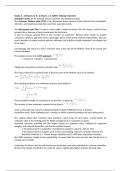Samenvatting
Summary articles week 3 Managing Customer Experience and Value
A summary of both articles from week 3 for the Managing Customer Experience and Value exam, RUG students. Articles summarized: Gupta, S., Lehmann, D. R., & Stuart, J. A. (2004). Valuing customers. Wiesel, T., Skiera, B., & Villanueva, J. (2008). Customer equity: an integral part of financial rep...
[Meer zien]




